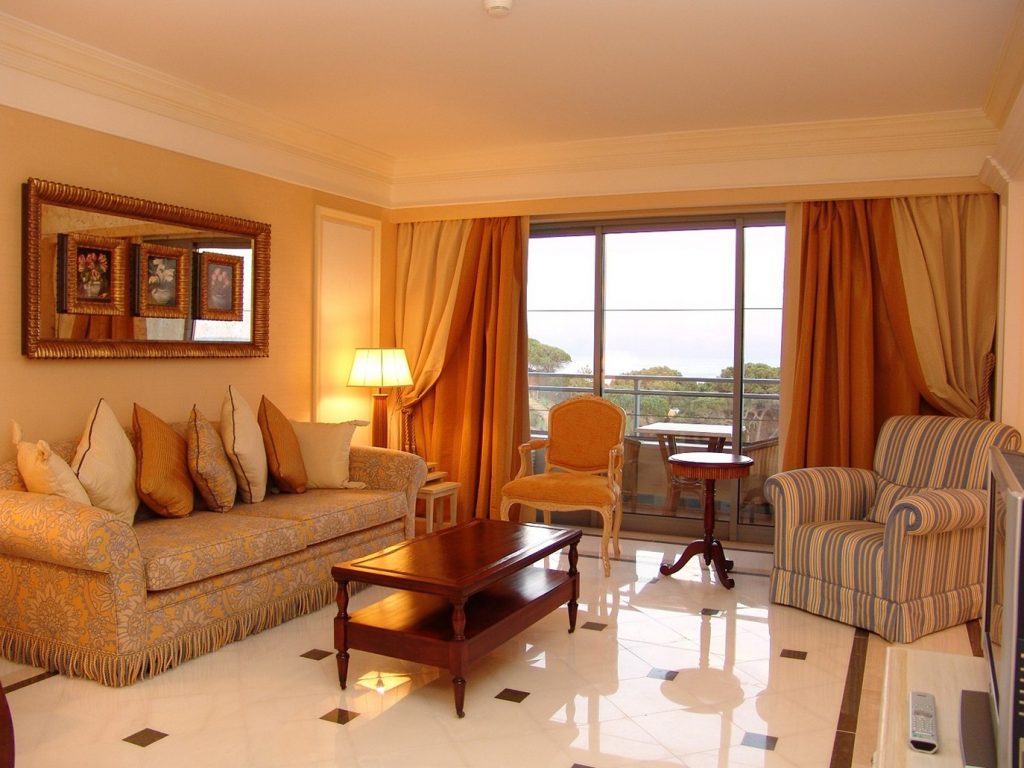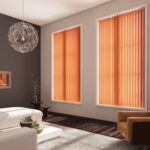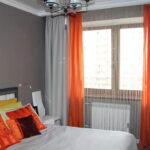Description and characteristics of orange curtains
Orange is a bright, sunny and positive color. It improves mood and invigorates, helps to get rid of depression and enhances concentration, stimulates the brain. Orange curtains in the kitchen, bedroom, nursery or living room can create a cozy atmosphere, but the wrong shade can be annoying.

- Feature of orange color in the interior
- Characteristics of orange curtains
- Advantages and disadvantages
- Types of orange curtains
- Choice of orange curtains, curtains and tulle
- Application in the interior
- Video: orange curtains in the interior of the rooms
- 50 interior design options with orange curtains
Feature of orange color in the interior
Orange comes from mixing red and yellow. He took the very best from both colors. Yellow muted the expression of red, resulting in a juicy shade that does not put pressure on the psyche. Like any other color, orange has a definite effect on humans. In psychology, it is widely used in the treatment of aggressive patients.

Orange helps to get out of a depressive pit and apathy, cheers up, and helps in negotiations. It is an active color that calls for action. Psychologists recommend using it in the design of children. Orange in the environment helps the child overcome his natural shyness and begin the difficult process of social adaptation. It pushes towards new goals, makes you move. Since the color is dominant, it overpowers its companions with ease.

Orange curtains or furniture grab attention. This color feature can be used to mask room imperfections that fade into the background. It is very important to choose the right combination of shades in the interior. With proper design, orange will flow into the atmosphere with bright notes. It is ideal for rooms with little sunlight.
Characteristics of orange curtains
Orange curtains are a pretty bold solution that can be integrated into almost any style. In modern trends, they use bright, and sometimes even shocking shades. For classic interiors, calmer tones are selected. Orange dominates the interior, so many are afraid to use it for fear of making the room too bright and tasteless. This color will organically integrate into the setting, if the designer will competently use its advantages and mask flaws.

Advantages and disadvantages
Orange curtains have a number of advantages:
- They help to make the interior warmer and fill the room with sunlight, so they are often used in the design of rooms with windows facing north.
- They attract attention, so they can only be used as an accent.
- Light shades of orange help to visually enlarge a small room.
- Creates a decorative lighting effect. Sunlight that passes through the thin fabric of the curtains diffuses beautifully.

The active color also has its disadvantages:
- Dark colors are not suitable for small and confined spaces.
- Poorly combined with other juicy shades.
- Not suitable for rooms facing south. The abundance of sunlight combined with orange curtains creates a feeling of unbearable heat.
Types of orange curtains
Orange curtains are classified into several types depending on the design:
- Sliding. The curtains are fixed vertically on the cornice. The length and width of the web can be adjusted.
- Lifting. The curtains are opened upwards with the help of special mechanisms.
- Stationary. These curtains are purely decorative. They are fixed to the eaves, do not open or close.

The first type includes classic, Japanese, crossed curtains. The lifting category includes Italian, English, Roman, French, Austrian. It also includes popular and practical roller blinds and German pleated blinds. Stationary ones are usually used in classic interiors. They are ideally integrated into Art Nouveau, Biedermeier, and palace style. For stationary curtains, orange is not the best solution. Its vibrant shades are more suitable for modern styles. Only copper, caramel, brick and ocher can be combined with the classics.

Choice of orange curtains, curtains and tulle
Orange curtains, curtains and tulle are a removable design element that can be replaced at any time, but this does not mean that their choice can be approached irresponsibly. First of all, you need to choose the type of curtains. Static are an essential attribute of the classics. They look pompous, so they do not fit at all with fusion, eco style, hi-tech or loft. Lift can be easily integrated into both modern interiors and neoclassicism.

Due to the variety of models, sliding curtains have become a versatile option for all styles. A compact Japanese version is more suitable for minimalism. Classic sliding curtains will be better combined with the interior, which is decorated in art nouveau style. When choosing the length of the canvas, you should rely on the height of the window and the environment.

If there is some massive piece of furniture under the windowsill, then there is no point in buying long orange curtains on the floor. Short curtains are more suitable here. The elegance of wide panoramic windows will be emphasized by long sliding curtains, which will be ideally combined with delicate, translucent tulle.

Application in the interior
Although many people like orange, they are afraid to use it in the design of rooms. The problem lies in the combination with other shades. It ruthlessly suppresses some colors, which makes the interior composition tasteless and ridiculous. Against the background of other shades, orange can fade into the shadow, which is unacceptable for such an active tone. Why then add it to the interior at all?

Orange does not always do well with other colors:
- Orange with red creates psychological pressure and can cause aggression and irritation.
- Orange and black looks brutal. This combination is well suited to austere interiors, but not at all suitable for a delicate design.
- Orange with brown helps to relax, soothes.
- Orange and white symbolizes the pursuit of purity and innocence. The combination is light and airy. Ideal for cramped rooms.
- Orange with green stimulates brain activity, so it can be used in the interiors of workrooms, but is completely unsuitable for bedrooms.
- Orange and blue create a contrasting combination. The combination is considered the basis of the nautical style.

For each room, a certain shade of this color should be chosen, since it significantly affects the psychological state of a person. Visual examples of design with a photo will help you choose the right orange curtains in the interior.
To the kitchen
Orange stimulates appetite. If the dining area is located in the kitchen, then the choice of color for the curtains becomes obvious. In this room, you can not restrain yourself and choose rich, rich shades. Ideal for a kitchen interior - a reference orange or rich carrot color.

To maintain harmony in the room, you should choose wooden furniture for the orange curtains. For interiors in classic styles, dark wood is suitable. Light wood in tandem with orange curtains will help to visually enlarge the room. To enhance the effect of the dominant color, it can also be complemented with “tasty” shades (coffee with milk, milk chocolate, vanilla) in the wall decoration.
Into the bedroom
It is not recommended to use bright shades of orange in the bedroom. They are too invigorating, and this is not conducive to sleep and relaxation. For bedroom curtains, you can choose golden copper, caramel, peach or mango shades. Its ideal companion for this space is white or sky blue.

Into the hall
Since the hall is a room of impressive dimensions, you can safely use rich shades of orange here. Such a spacious room is conducive to unusual experiments. In the hall, you can resort to a complex combination of orange and black. If the room is decorated in a classic style, then stationary curtains are ideal, which will add a touch of elegance and chic to the atmosphere.

To the living room
The living room is a “family” room in which households gather for friendly gatherings with friends. Here it is important to create a cozy atmosphere that slightly invigorates and helps to relax, promotes dialogue. Orange is ideal for this role. You can use both bright and less saturated colors. Orange curtains in the living room interior become either a background or an accent. In the first case, they will go well with solid wood furniture. The orange color will set off the natural grain of the wood. When the curtains become an accent piece of decoration, they will be complemented by furniture and furnishings in soft milky shades.

To the nursery
Orange curtains in the nursery will refresh the environment. Psychologists have long established that bright colors in the interior are good for the child. They stimulate him and lift his spirits. In the nursery, you can use bold combinations of orange with lilac, blue, green or yellow. It is not recommended to complement bright curtains with red interior details. This combination overloads the environment and backfires. Instead of cheerfulness, it can irritate and cause aggression.

Video: orange curtains in the interior of the rooms































































